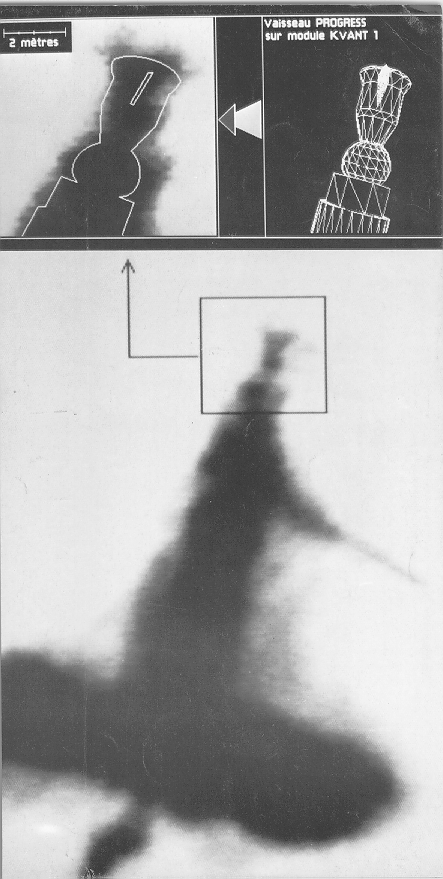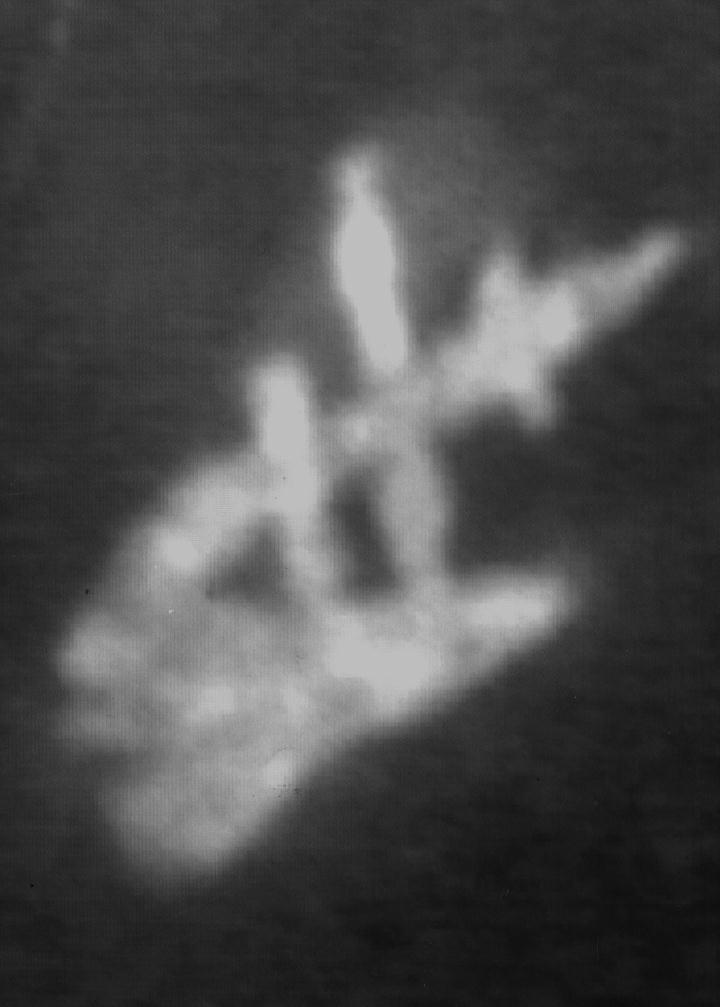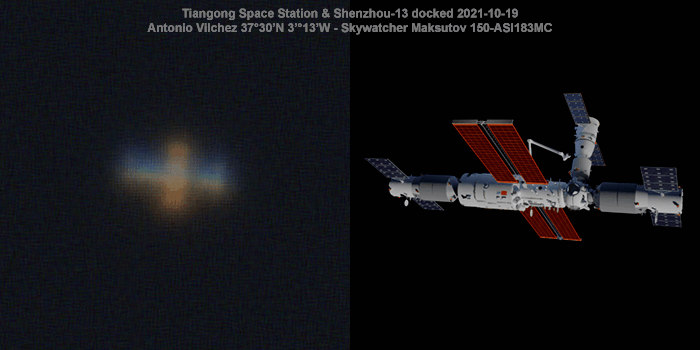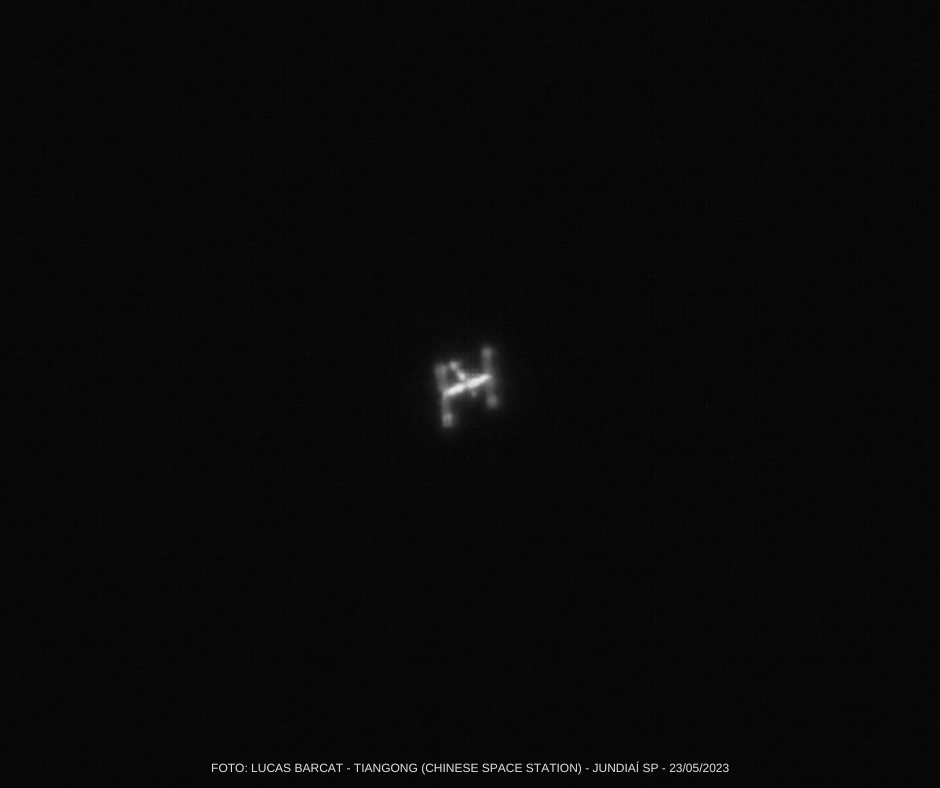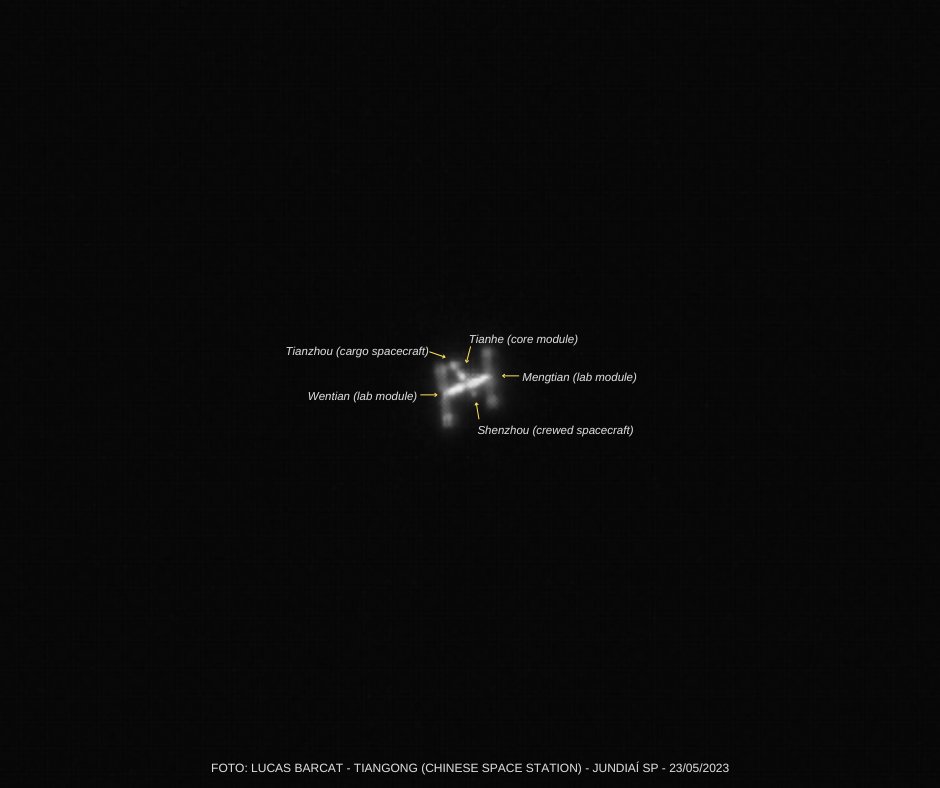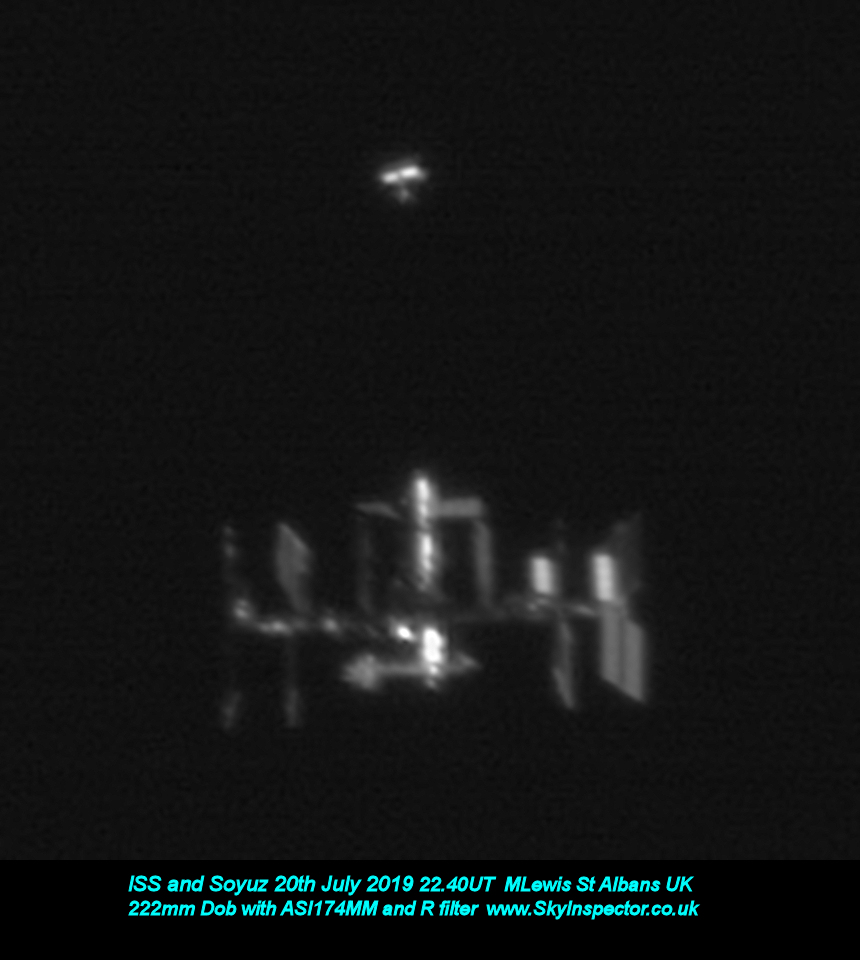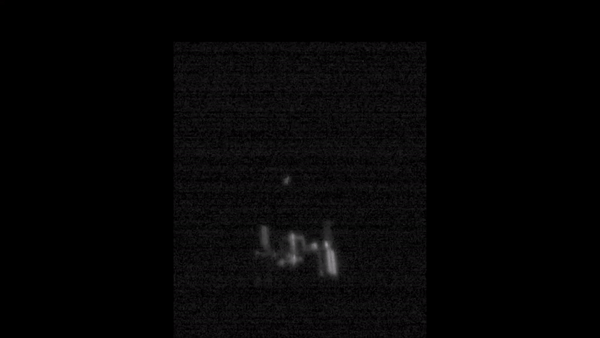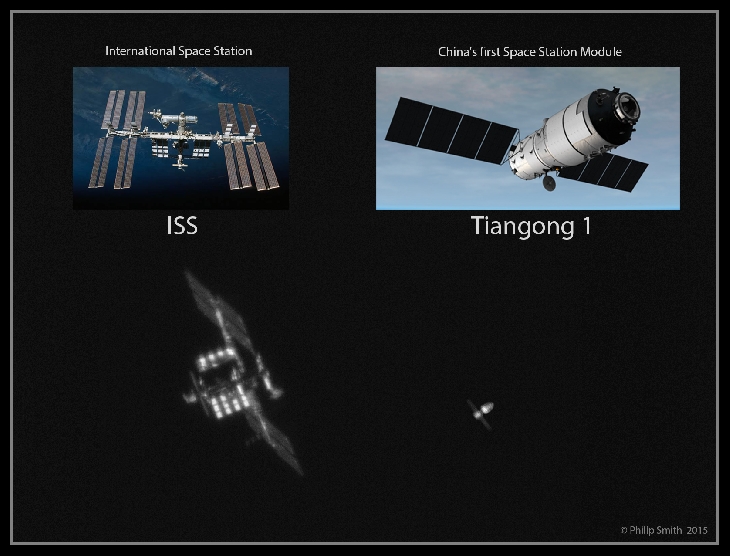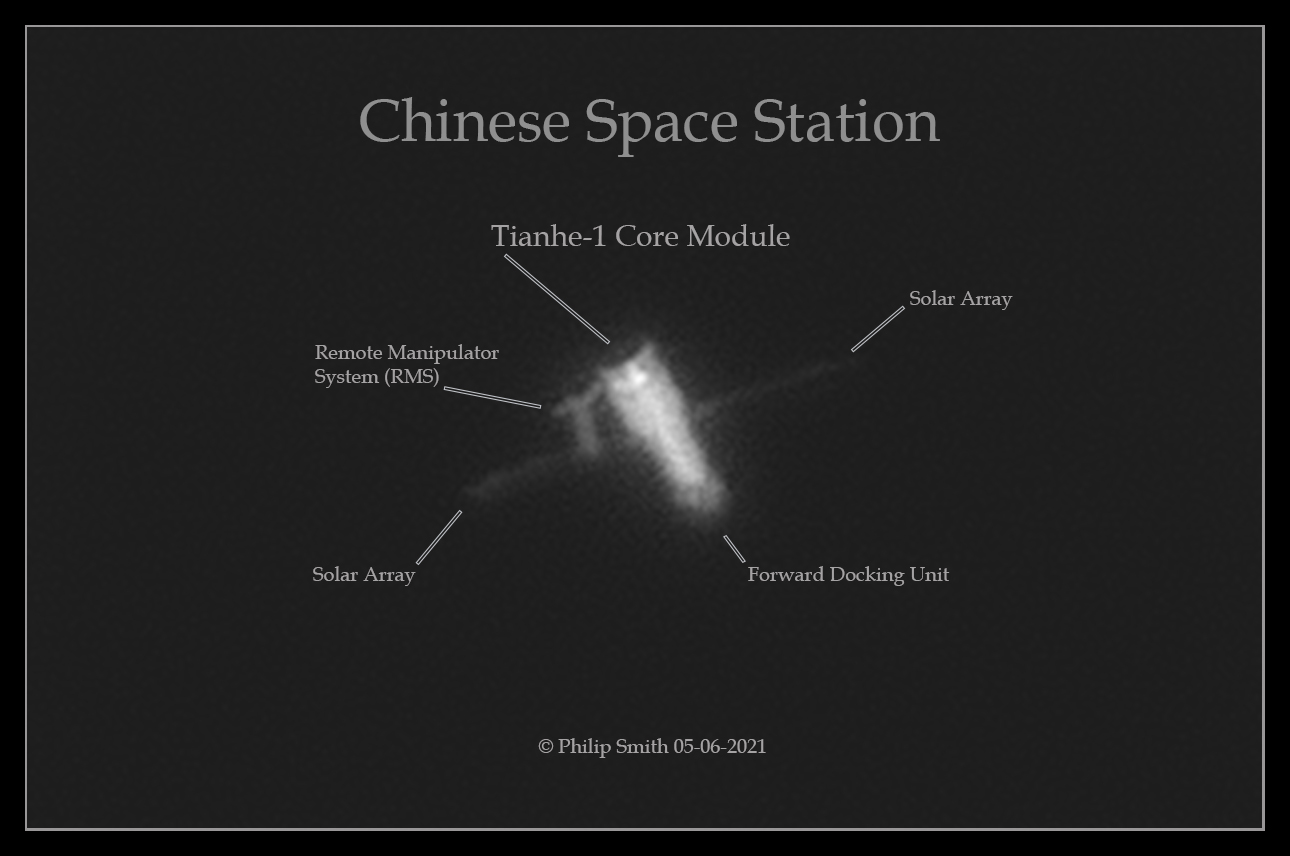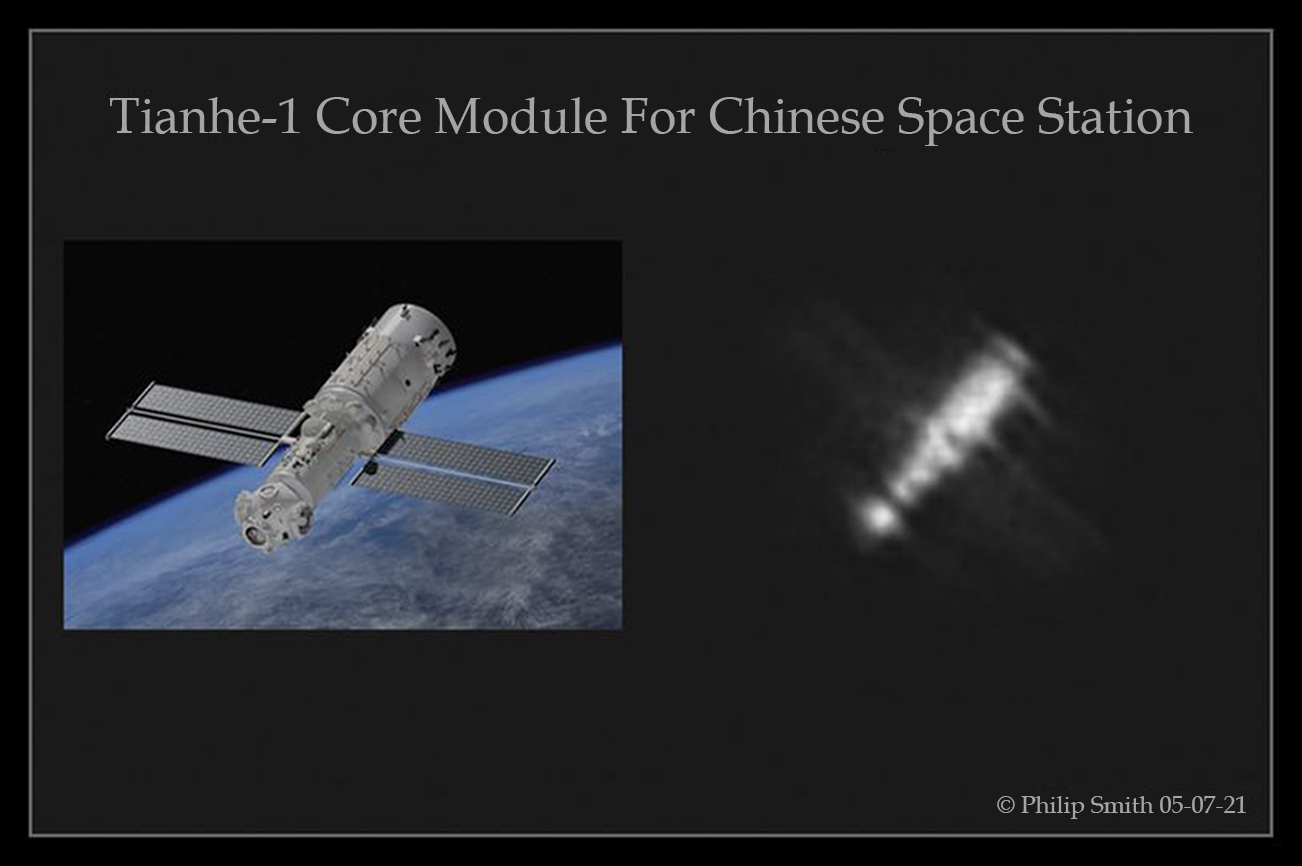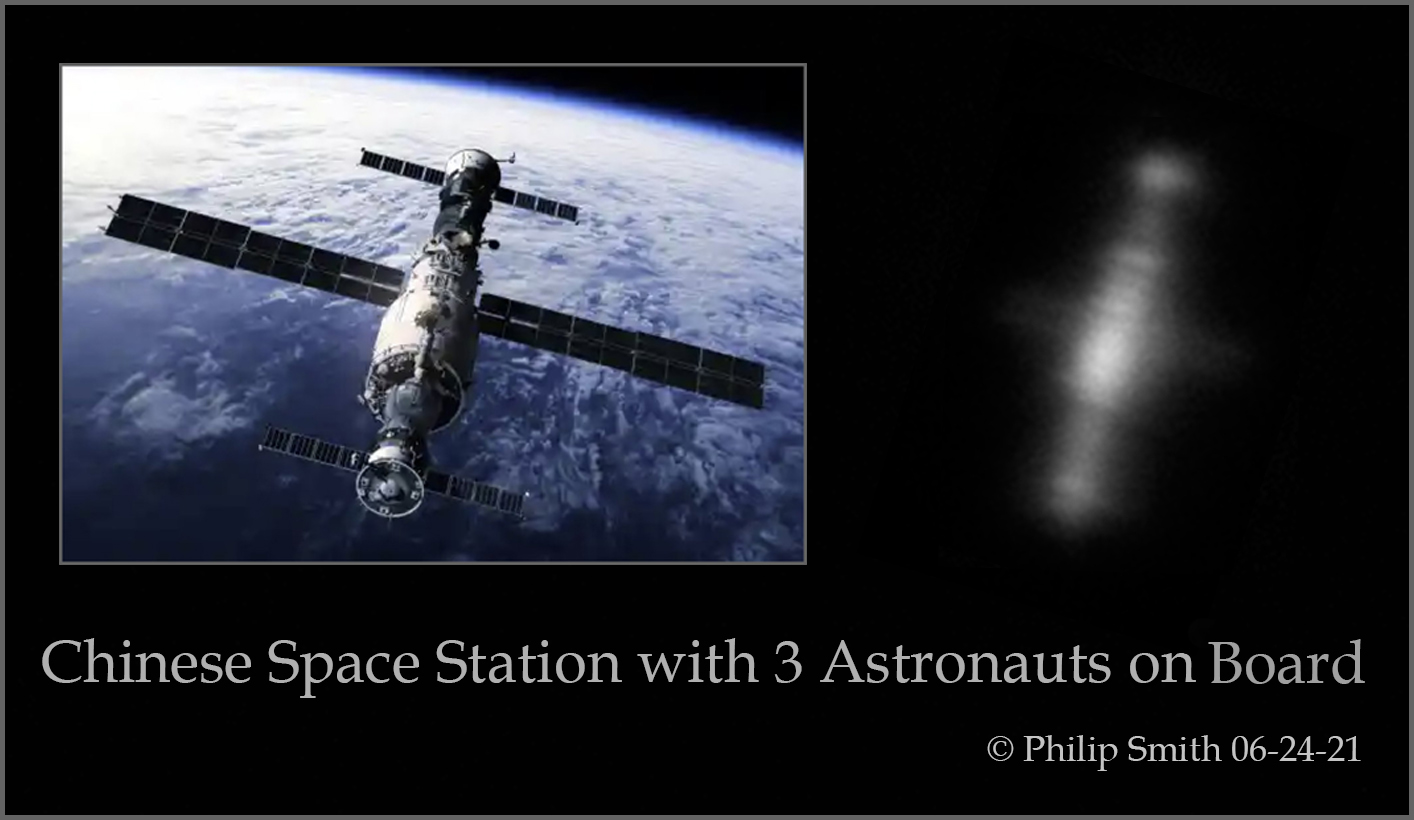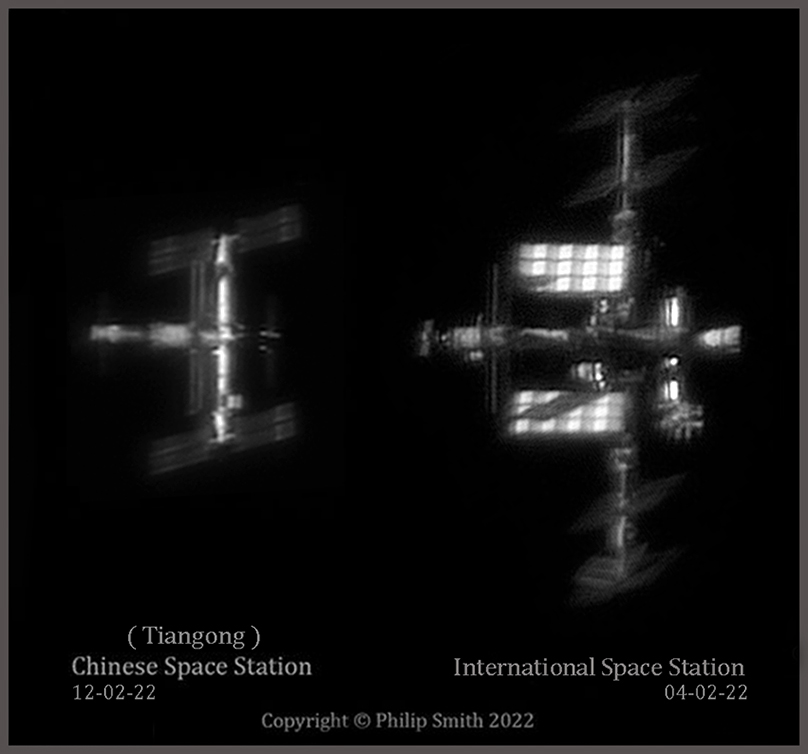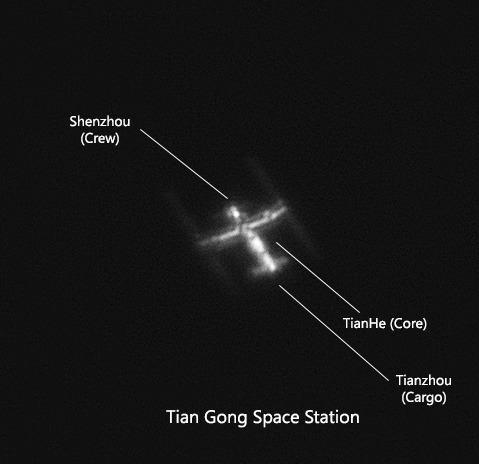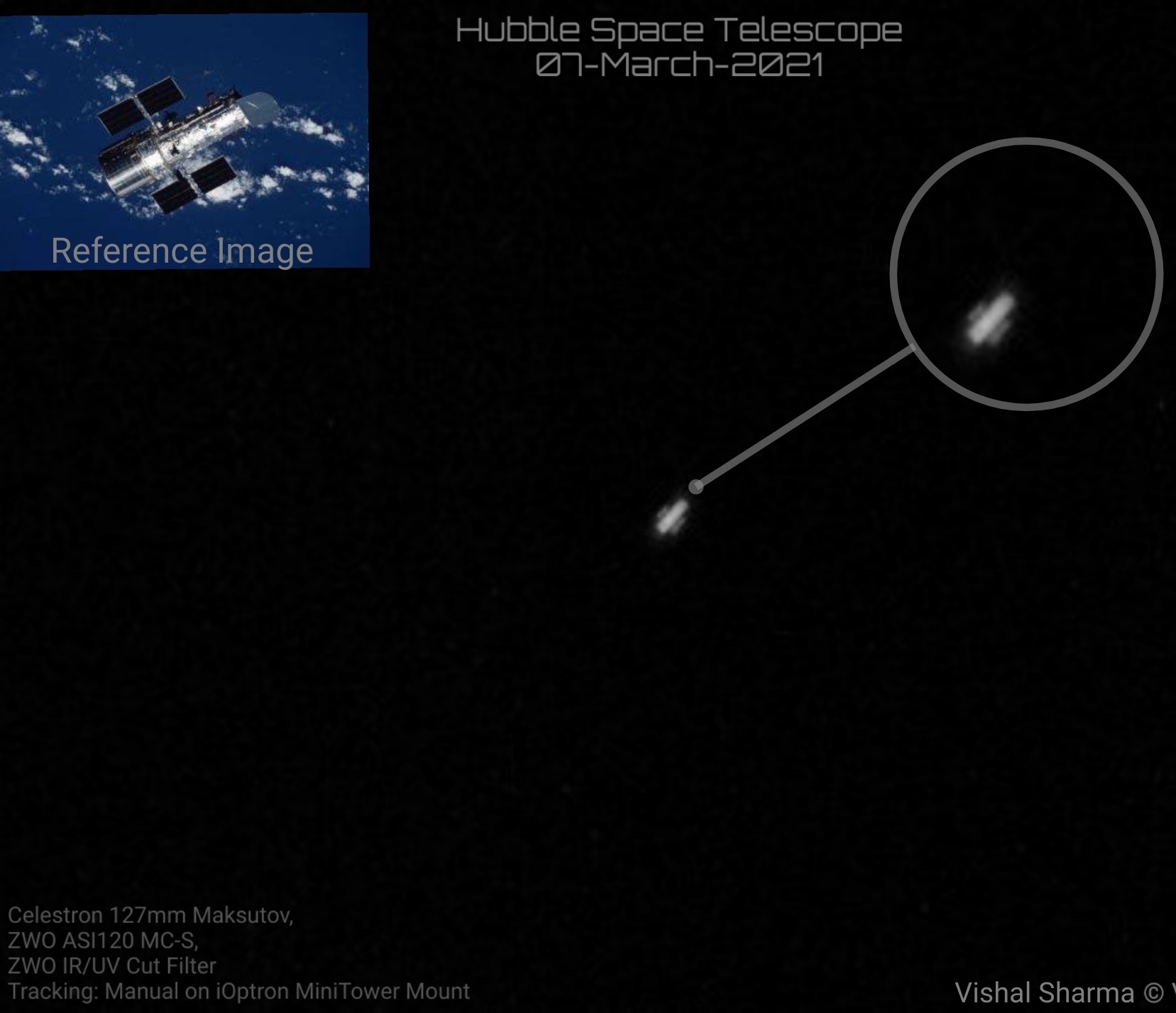Alain Grycan – MIR space station, Antonio Vilchez – Tiangong-1 space station, Chinese Space Station, Blake Trujillo – ALOS satellite, Ethan Roberts – SpaceX Dragon CRS-16, Lucas Barcat – Chinese Space Station, Martin Lewis – ISS and Soyuz MS-13, Philip Smith – Tiangong-1 Space Station, Philip Smith – Tianhe Space Station (first module), Philip Smith – Tienho + Tianzhou-2 + Shenzhou-12 (Chinese Space Station), Stephen Wong – Chinese Space Station, Vishal Sharma – Hubble Space Telescope
(click on names above to jump)
Alain Grycan
Alain’s Flickr page
MIR Space Station
Alain Grycan and Eric Laffont from France have obtained the most spectacular amateur-made images of MIR (that we’ve seen). This (negative) first image is an example of their work. It appeared in Flash (the newsletter of the Belgian Working Group Satellites) in 1991. The different MIR modules are clearly visible. Also clearly discernible to the right is the Sofora mast structure. The zoom-in (at top) shows the Progress motor compartment, compared to a computer-generated drawing. Their second image was taken during the June 1995 Mir/STS-71 mission; both craft are clearly outlined.
Antonio Vilchez
(His twitter, astrobin and facebook profiles)
Tiangong-1
Tiangong-1 – 2016/08/21 Dobson Orion XT12i ZWO120MC 2.25X
Chinese Space Station
Blake Trujillo
(Blake’s Instagram profile)
Advanced Land Observing satellite
Images were captured via manual tracking from my backyard in Saginaw, Michigan. Date: 09.092021
Equipment: Apertura AD8 Dobsonian, ZWO ASI462MC, Apertura 2X barlow, Svbony IR/UV Cut filter.
Ethan Roberts
(Ethan’s Instagram profile)
SpaceX Dragon cargo spacecraft
Lucas Barcat
(Lucas’s Twitter profile)
Chinese Space Station
I am very happy to be able to share my capture of the Chinese Space Station observed here in Brazil. First I want to say that the images present in “Space Station Guys” are an inspiration to me.
I follow the Chinese station using the Heavens Above application, on May 23, 2023 at 18:00 (GMT-3) I had the opportunity to capture it in a park near my apartment. This day was a great opportunity because its brightness would be intense with magnitude -4.2 and 100% illuminated. It was an infinite happiness to be able to capture this beautiful work of space engineering. For the capture I used some equipment:
Telescope: Orion Dobsonian Telescope 203 x 1000mm f/4.9 + Scope 5×24.
Camera: ZWO ASI462MC – 1936×1096 – 2.9um – Diagonal 6.46mm – IMX462 sensor.
Software: FireCapture
edit: gimp
Martin Lewis
(Martin’s website profile)
International Space Station and Soyuz spacecraft
Tiangong-1
Tianhe
I was lucky to image a somewhat high resolution image of Tianhe-1 Module to the China Space Station from Manorville, NY in my backyard observatory. I was determined because a had many pass that ah rainy or cloudy weather. So this was my chance on May 05-2021 at 03:54:13 ETS the Tianhe-1 Module would exits form Earths shadow at 56°. So it does not give me much time to see it and the try to image. The max height was 75° at 03:54:46. The sky look very clear at that time. The seeing was poor according to my weather information from Clear Sky Chart. My imaging configuration was an OTA Edge HD 14 ′′ telescope with an Baader Red 610 nm Longpass Filter – 1.25″ on a ZWO ASI174MM (mono) camera and Baader Planetarium Carl Zeiss 1-1/4″ Abbe Barlow Lens 2x. All on a custom built Orion EQ-G mount and custom software.
All images were from my backyard observatory in Manorville NY, USA.This is a composite image of the International Space Station that I imaged on 05-06-21 and the Chinese Space Station Tianhe-1 Core Module that I imaged on 05-19-21. Please Note: My imaging configuration was the same for both Space Station images. My imaging configuration was an Edge HD 14 ′′ telescope with an Baader Red 610 nm Longpass Filter 1.25″ on a ZWO ASI174MM (mono) camera at full sensorI 1936 x 1216 and Baader Planetarium Carl Zeiss 1-1/4″ 2x Barlow Lens. This is to scale and would look like if the two Space Stations were flying side by side. I think I am the first amature astronomer to get these high resolution images of the Chinese Space Station to make this composite image. The International Space Station and Chinese Space Station were imaged at the same height. I hope in time to get even better images to share. For know I have truly documented history with my images and for the space community.
Chinese Space Station
China’s new space station is now occupied. Astronauts Nie Haisheng, Liu Boming and Tang Hongbo are onboard, preparing the outpost for expansion. On June 24th the crowded station flew over my observatory on 06-24-21 from Manorville, New York. I think I may be the first to image 3 Astronauts On Board Chinese Space from the ground. The seeing was not good. The (CSS) Chinese Space Station pass was at 80° and the Sun was -11°. I did not see the solar panels in this pass in the way I hoped to image them. I will keep trying to get a better image to share with you. My imaging configuration was an Edge HD 14′′ telescope with an Baader Red 610nm Longpass Filter 1.25″ on a ZWO ASI290MM (mono) camera at full sensor and no barlow.
ISS and CSS comparison
I put my CSS and ISS into this one image to share with you. This is the setup and information for each of them. 1st the CSS > History was made with 6 Chinese astronauts now onboard Tiangong. I had the rare opportunity to record this HISTORY over my home. I imaged the Chinese Space Station ( Tiangong ) on 12-02-22 Max 80° 5:55pm EST in average seeing conditions from my Manorville NY Observatory. My imaging configuration was an Edge HD 14″ telescope with and Red Chroma 1.25″ filter on a ZWO ASI174MM camera and Baader 2x Barlow Lens. All on a modified Orion Atlas EQ-G mount setup in Alt-Az configuration. 2nd ISS > I also imaged the SpaceX Crew-3 Endurance, docked to the International Space Station at 8:33pm EST on 04-02-22, from my Manorville, NY USA backyard observatory. The pass was at max 84° but, the full sky had a thin layer of clouds. This image is a stack of 50 frames from my recording. My imaging configuration was an Edge HD 14 ′′ telescope with and Baader Red 610 nm Longpass 1.25″ filter on a ZWO ASI290MM (mono) camera No barlow, all in a MoonLite focuser on a Atilius Orion EQ-G mount modified.
X-37B
I was in the hunt for the X-37B Spy Plane. I had a chance to try and image the 89° pass over my Manorville, NY USA observatory. The Sun was -15 ° in the east so it was still dark enough to see X-37B on 10-02-21 at 5:29 am EST. This was the first time I saw X-37B Spy Plane. I let out a loud audible “GOTCHA” followed by a huge smile. I just wish the seeing would have been better at the same time. I found this X-37B Spy Plane informing written by Mike Wall : “The U.S. Air Force’s unmanned X-37B space plane has flown four clandestine missions to date, carrying secret payloads on long-duration flights in Earth orbit. The X-37B looks a lot like NASA’s iconic space shuttle, but the two types of vehicles don’t resemble each other in size. The X-37B is just 29 feet (8.8 meters) long, with a wingspan of 15 feet (4.6 m). The now-retired space shuttle orbiters, by contrast, were 122 feet (37 m) long and measured more than 78 feet (24 m) from wingtip to wingtip. Two X-37Bs could fit inside the shuttle’s cavernous payload bay. Indeed, the X-37B’s designers originally envisioned the shuttle carrying the smaller space plane to orbit but ultimately decided that launching the X-37B atop a rocket would be more economical. The X-37B has ridden to orbit atop two different boosters to date United Launch Alliance’s Atlas V and SpaceX’s Falcon 9. Like the space shuttle, the X-37B lands on a runway, plane-style, but does everything autonomously (in contrast to the piloted shuttle, which usually carried a crew of seven astronauts). The X-37B missions are classified. Although the Space Force has disclosed some of the payloads that have flown aboard the X-37B, most of the space plane’s gear is classified, as are the details of its orbital activities. This secrecy has led to some speculation that the vehicle is some sort of space weapon, perhaps one designed to take out or capture satellites. However, military officials have always denied this notion, insisting that the X-37B is just testing out technologies for future spacecraft and carrying various experiments up to space and back. Some of the technologies being tested are likely sensors and other equipment for future spy satellites, outside experts have said. ” My imaging configuration was an Edge HD 14′′telescope with an Baader Red 610 nm Longpass Filter 1.25″ on a ZWO ASI174MM (mono) camera and Baader Planetarium Carl Zeiss 1-1/4″ 2x Barlow Lens. All on an EQ-G mount custom inside and out with ISS tracking hardware and software system made for me by Emmanuel Rietsch. I assembled and modified my mount and pier.
Stephen Wong
Vishal Sharma
Hubble Space Telescope
